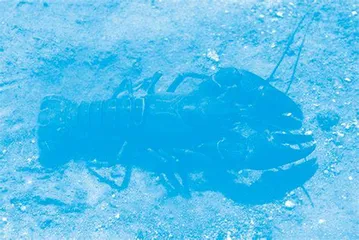Is “Invasivorism” Really the Answer?吃光入侵物种真的是解决之道吗?
作者: 帕特里克·格林菲尔德 贺丛芝/译

From oral contraceptives to proposals to edit their DNA, efforts to control the UK’s invasive grey squirrel population have become increasingly elab-orate. But a growing number of chefs and conservationists have a far simpler idea, which they see as part of the trend in ethical dining: eat them.
从投喂口服避孕药到提议编辑基因,为了控制英国境内入侵灰松鼠的数量,人们所做的努力越来越复杂。然而,越来越多的厨师和环保人士主张一个简单得多的办法,他们将其视作道德饮食潮流的一部分。这个办法就是——吃掉灰松鼠。
“My original starting point with grey squirrel was taste. But it’s also great for the environment,” says Paul Wedgwood, one of Scotland’s leading chefs, whose restaurant on Edinburgh’s Royal Mile has had grey squirrel on the menu since 2008. Wedgwood has even made haggis1 from the North American rodent that has driven the local extinction of the native red across much of England and Wales.
“我烹饪灰松鼠的出发点是追求美味。除此之外,这对环境也非常有益。”身为苏格兰顶级厨师之一的保罗·韦奇伍德说。他的餐厅位于爱丁堡的皇家英里大道,从2008年起就把灰松鼠列入菜单。韦奇伍德甚至用这种北美啮齿动物制作苏格兰名菜“哈吉斯”。灰松鼠已导致英格兰和威尔士大部分地区的本土红松鼠灭绝。
Wedgwood is not alone among chefs putting invasive species on the menu. At Dai Due restaurant in Austin, Texas, owner and chef Jesse Griffiths is encouraging Americans to eat more of the millions of feral hogs that cause billions of dollars of damage to farmland. In the Bahamas, Michelin-starred chef José Andrés is serving up invasive lionfish to help protect reefs in the Caribbean. At Fallow in London, chefs are planning to cook king crab, the latest arrival on British shores that has sparked fears for native brown crab and scallop populations.
韦奇伍德并不是唯一将入侵物种列入菜单的厨师。在美国得克萨斯州奥斯汀市的Dai Due餐厅,老板兼主厨杰西·格里菲思鼓励美国人多吃野猪,因为数百万野猪给农田造成了数十亿美元的损失。在巴哈马,米其林星级厨师若泽·安德烈斯把入侵狮子鱼端上餐桌,以帮助保护加勒比海的礁石。在伦敦的“休耕”餐厅,厨师们计划烹饪帝王蟹。这种蟹最近才出现在英国的海岸上,但已经引发人们对本土面包蟹和扇贝种群的担忧。
The concept of “invasivorism” was developed more than two decades ago by Joe Roman, a conservation biologist2 at the University of Vermont. “With this idea, humans are a form of biological control. Humans are amazing predators: whether it’s eating the grey squirrel in Britain or the European green crab in the U.S., we know eating them can have an impact on populations,” he says.
20多年前,佛蒙特大学保护生物学家乔·罗曼提出了“入侵物种食用主义”的理念。他说:“基于这一理念,人类本身就是一种生物防治工具。人类是了不起的捕食者。不管是在英国吃灰松鼠,还是在美国吃欧洲青蟹,我们知道吃掉它们会对种群产生影响。”
The spread of invasive species counts among the major drivers of extinctions and biodiversity loss on Earth, according to leading scientists. Not all non-native organisms become invasive, but those that do spread rapidly and outcompete native wildlife, often due to the absence of predators, causing financial and ecological damage. Examples include mice on Gough Island in the south Atlantic where the rodents eat albatross chicks in their nests, and the Burmese python in Florida’s Everglades, which has devastated mammal populations. Invasive species are also expensive: a Queen’s University Belfast study revealed that they have caused £878bn of damage worldwide since the 1960s, a bill set to spiral this century.
多位顶尖科学家称,入侵物种扩散已成为地球上物种灭绝和生物多样性丧失的主要原因之一。不是所有外来生物都会成为入侵物种,有此名号的物种往往因为没有天敌而迅速扩散,它们战胜了本土野生动植物,进而造成经济损失和生态破坏。南大西洋高夫岛上的老鼠和美国佛罗里达州大沼泽地的缅甸蟒蛇就是例子。前者这种啮齿动物会吃掉鸟巢中的信天翁雏鸟,而后者已经对本土哺乳动物种群造成致命打击。入侵物种带来的经济损失也非常大。贝尔法斯特女王大学的一项研究显示,自20世纪60年代以来,入侵物种已在全球造成8780亿英镑的损失,这一数字将在本世纪加速上升。
Conservation biologist Joe Roman runs the website EatTheInvaders.org, hosting recipes for invasive species in the U.S. that include the green iguana, wakame seaweed and nutria or coypu—a river rat.
保护生物学家乔·罗曼运营的EatTheInvaders.org网站主打以美国入侵物种为食材的菜谱,这些物种包括绿鬣蜥、裙带菜、海狸鼠(又称河狸鼠,一种生活在河边的老鼠)。
“We need to say from the beginning that the goal is to reduce these populations—not to create a market for them. We don’t want people to say ‘wow, this crayfish is really good. I wish we had it in this river system’ or something like that,” Roman says. “In this time of globalisation, we’re moving animals, plants and fungi around all the time that have ecological impacts. We are trying to work against that.”
“首先要说的是,我们的目的是减少入侵物种的数量,而不是为它们创造市场。我们可不想听到人们说‘哇,这种小龙虾真好吃,希望我们本地的河里也有’,也不想听到其他类似的话。”罗曼说,“在这个全球化的时代,我们一直把对生态有影响的动物、植物和真菌带往各处。我们正在努力消除这种生态影响。”
Critics are wary of how effective invasivorism can be at achieving its aims, with evidence the “eat them to beat them” approach can have the opposite effect for some species. A 2020 paper on catching invasive signal crayfish populations in North Yorkshire, where Britain’s only native crayfish is being driven out, found that traps were likely ineffective and helped spread the crayfish. Despite the crayfish being promoted by chefs including Gordon Ramsay, the report found that less than 2.5% of invasive crayfish were large enough to be caught in traditional traps, which could harm other creatures.
对于食用入侵物种能否实现目标,评论家们持谨慎态度。有证据表明,对有的物种而言,“吃掉它们以击败它们”的方法可能适得其反。2020年发表的一篇有关在北约克郡捕捉入侵通讯螯虾的论文显示,捕虾网可能不仅没用,反而还助长了通讯螯虾的扩散。通讯螯虾正在将英国唯一的本土螯虾赶出北约克郡。尽管戈登·拉姆塞等厨师在推销通讯螯虾,但论文写道,只有不到2.5%的入侵螯虾大到可以用传统的捕虾网捕获,而且捕虾网也可能伤及其他生物。
Then there is the question of scale. The Wild Meat Company, which sells game from Suffolk, England, sold about 10,000 grey squirrels in 2021, hardly enough to dent the population of 2.7 million in the UK.
此外,吃掉的数量也是一个问题。2021年,出售英格兰萨福克郡野味的“野味”公司售出了大约1万只灰松鼠,远不足以威胁英国总数达270万的灰松鼠种群。
In the US, a 2014 review found that while eating invasive species can reduce populations and raise public awareness, it might inadvertently provide disincentives to their eradication. It offered an 11-point strategy for using invasivorism effectively, along with following local laws on harvesting species, which differ around the world.